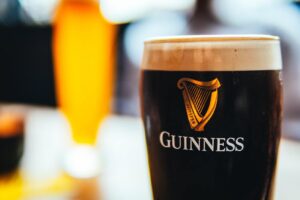beerducation


Beer Pairing 101
Hold my beer and move over wine!

WINE VS. BEER
Although wine has historically been the go to for pairing with food dishes, beer has been working its way into the scene more and more as breweries create beer flavors that can match with food even better. But, how does one go about pairing beer with food? Most of us know that a white goes great with fish and a red goes great with a steak, but where does an ipa fit in, or a milk stout? If these are answers you are searching for, you have come to the right place!


MORE VARIETY
Unlike wine, beer has many more options as far as variety goes. Wine comes from two places – grapes, and grapes with wine barrel aging (still grapes). Beer on the other hand can come from hops, barley, and yeast. The hops help add bitterness, while the barley gives brewers the ability to sweeten the deal. Meanwhile, adding yeast helps with a bready style flavor. Then there are added flavors that can come from fruit, vegetables, spices, nuts and even chocolate. If it’s edible, it’s been tried in beer. There is even a brand of beer brewed with Rocky Mountain Oysters!
QUICK PAIRING TIPS
Fruit Beers
Pairs Well With: Light white meats such as chicken or fish. Pork and duck with sweet flavors (if tart/sour don’t use a fruit beer). Food with lots of spices and herbs. Fruity salads and desserts, and even pickled dishes!

Pilsner Beers
Pairs Well With: Cheeses such as havarti, american, muenster or monterey jack. Good for spicy foods, asian dishes, salads, and lighter seafood dishes such as salmon, tuna, trout. If serving veggies dishes, this also works well!

Wheat Beers
Pairs Well With: Sushi, lighter dishes such as veggie, salads, light soups. For cheeses try a mediterannean cheese like Feta or goat cheese. This great to try with fruity dishes, so pair with sweeter asian dishes, citrus style dishes including desserts. Some even make a salad dressing with this type of beer!

Porter Beers
Pairs Well With: Protein packed meaty flavored dishes. Try with red meats, bacon, chili, heavier toting flavored entrees. Matches very well with barbecue and smoked foods!

Lager Beers
Pairs Well With: All around good beer, but not as great for heavier richer entrees. Experiment with seafood and shellfish, sushi, grilled chicken and pork, mexican/latin foods, and spicy foods in general.

Ale Beers
Pairs Well With: This is the go to for game day foods! This category will set you right for burgers, fried foods, wings, cheesy foods, and pizza!

Stout Beers
Pairs Well With: Similar to its cousin the porter, stout beers compliment smoked and barbecue dishes quite well. Stouts are also great for cutting back the saltiness of certain meals such as oysters and stews, along with desserts, especially chocolate. The beer is expected to be sweeter than the dish itself.



Now that we have covered the basics of what goes with what, let’s go into more detail of things to pay attention to!
Start with what you like to drink. Yep! Rather than try a new beer with a new dish, start with some common ground. If you have a favorite beer, find out what would pair well with it, rather than what beer will pair well with a random dish. Have fun experimenting!

Start with what you like to drink. Yep! Rather than try a new beer with a new dish, start with some common ground. If you have a favorite beer, find out what would pair well with it, rather than what beer will pair well with a random dish. Have fun experimenting!
Finding common ground again, try comparing beers to wine. Important to note, there are two main types of beer, lager and ales. Lagers are usually more delicate and crips, while ales are more robust and fruity. That being said, some like to compare lager to white wine and ale to red wine. Simply put, beer hops function like the acids in wine during pairings. The stronger the hops (IPAs), the more similar to a white wine that helps cut through saltiness, oil and fattiness. This is similar to the lemon counterpoint of a fish dish!
Heavy Bodied
Wines: Oak style Chardonnay, Cabernet Sauvignon, Malbec
Beers: Barleywine, Stout, Porter
Medium Bodied
Wines: Syrah, Merlot, Zinfandel
Beers: IPA, Ale, Bock
Light Bodied
Wines: Barbera, Pinot Noir, Sauvignon Blanc, Pinot Grigio
Beers: Wheat, Lager, Pilsner


YIN & YANG, OR ONE WITH ALL?
There are two main mindsets when pairing. One of those is to choose flavors that are similar to each other, the other is to pick options that are drastically different. As an example, if you are creating a spicy Mexican dish, you could pick a spicy beer, perhaps something that even has hatch green chile. This would bring out the flavors of both the dish and drink with each new bite and sip. The other route would be to choose something that balances the heat of the dish, perhaps a crisp cider that takes away a bit of the bite. In this way you are creating a sort of yin and yang with your meal, offering two main flavors in the same course! Remember that with food, your main bam in your mouth flavors will come from the sauce, your protein(typically a meat), and your method of cooking (grilling for example).

MATCHING REGIONS WITH FOOD STYLES
Just because you are cooking a spicy asian dish doesn’t necessarily mean you need an asian beer to go with it. Again, start with types of beers you enjoy. You might just find that your favorite Mexican lager goes great with your pho! When you go out to eat, most restaurants will house the common favorites that sell, along with their ethnic regional beers. Greek beers in a greek restaurant, mexican beers in a mexican restaurant, Japanese beers in a Japanese sushi house. One of the wonderful things about pairing food dishes with beer, is you get to do it your way! As a quick tip, spicy foods do usually pair well with stronger flavored fruity beers. Hefewiezens, wheat beers and lighter ales work well so you don’t fill up on hops. Whatever you pick, the cold nectar of the gods will be heaven on the palate!

BUBBLES AND TEMPERATURE
Something often overlooked is the temperature of your beer. You open up your brew before dinner, chat with friends and have a soup or salad, and when the meal arrives to match the beer you have been drinking, it’s halfway gone and halfway warm. This can drastically affect the entire plan! Ever notice how your beer becomes syrupy? It’s become too warm. Make sure you are drinking properly chilled beer, usually best served around 40-50 degrees, fahrenheit of course. Carbonation also plays a key role in how well everything will match together. The more bubbles, the more it helps cut through fats and cheeses. Take pizza for example, a favorite for many. A wheat beer may have worked for spicy dishes, but now would be too light and too fruity. A stout and most porters would be too heavy. However, a solid ale, lager or pilsner would compliment nicely. The carbonation washes everything down, and the hops battles the cheese! A word of advice, it’s always better to start with lighter beer and work toward heavier beers later in the meal, otherwise you might never make it through dinner!

